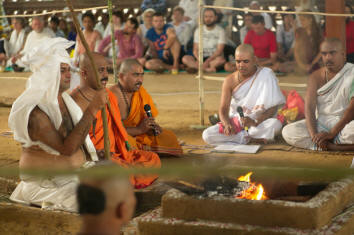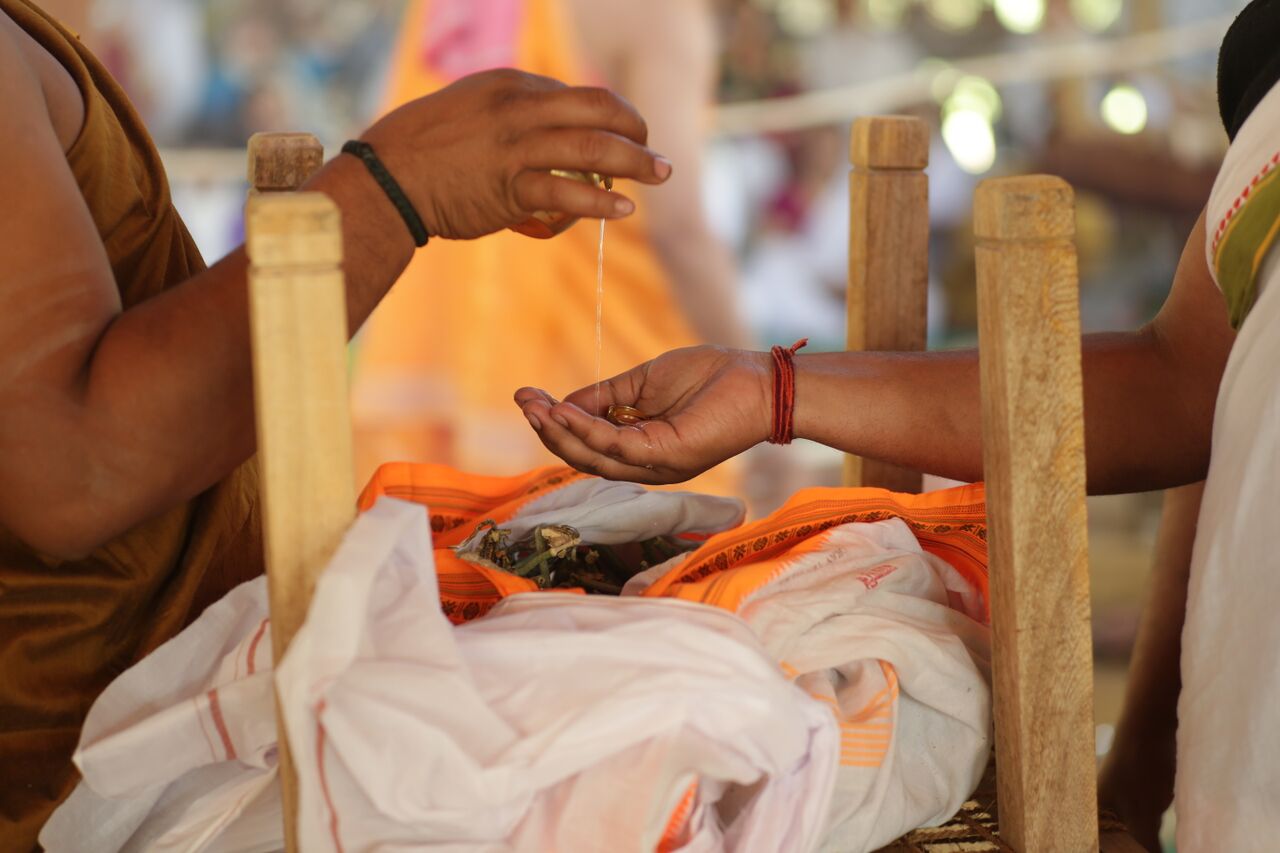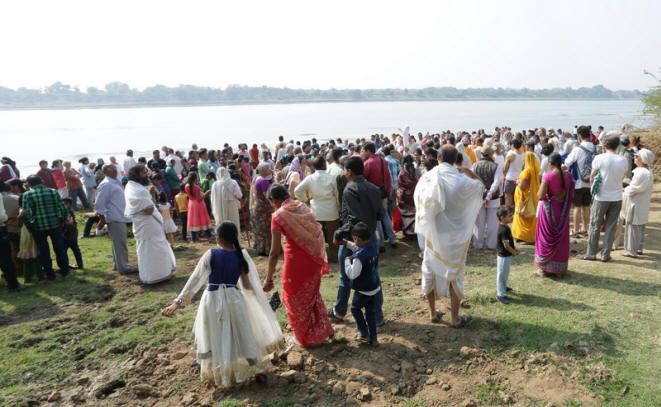Somayag–Part V
The Somayag Committee, Bruce Johnson and Ed.
It was the vision of Shree Vasant Paranjpe to complete a series of seven Maha Somayags on the banks of the Narmada River in Maheshwar, Madhya Pradesh, India, for the healing of our planet. February 12th, 2017 marked the successful completion of the Aptoryam, the seventh and final Somayag in this series
As in the previous Somayags held at the Homa Therapy Goshala in Maheshwar, India, the basic procedures were as follows:
- Bringing the fire from Tretagni Agnihotra.
- Ishti fire. Ishti means whatever is inside us we offer to God. It is a basic requirement for the other steps of the Somayag.
- Pravargya for three days. This is preparation for the Soma offering.
- Soma offering.
- Wrapping up–final offerings and prayers.
- Bath in the Narmada River.
Arrival of the Tretagni Fire

In the afternoon on February 6th, 2017 the arrival of the Tretagni fire was celebrated with a procession, drumming and dancing. Yajaman Achal Apte led the way, carrying the box containing the Tretagni fire from their home. (Tretagni Agnihotra is the ancient, long form of Agnihotra, which requires great discipline and unwavering commitment. Achal and his wife Bhakti Apte perform Tretagni Agnihotra, and transported that fire with them to Maheshwar. Only a performer of Tretagni Agnihotra is qualified to be a Yajaman for Somayag.) The fire was carried to Shree Vasant’s house, where participants were permitted to take Darshan, then to Kusum, Paranjpe, Shree Vasant’s widow, and finally to the Somayag Shala.

Day One—February 7th
The first day included the opening ceremony, energetic clearing of the Yajnya shala space, gathering the team of priests, transferring fire from Tretagni Agnihotra altars to Somayag altars, and consecration (Diksha).

In the opening ceremony, hosts Abhay and Anjali Paranjpe, plus the Yajaman, his wife and the rutvijas, assemble before the Tretagni altars just outside the boundaries of the Somayag Shala. Prayers are offered, asking that this Somayag go as smoothly as the previous six. Each of the deities is invoked by name. Specific details are given. For example, the exact location of this Somayag, the name of Abhay Paranjpe, as representative of those organizing this Somayag, is mentioned, his father’s name. Shree Vasant Paranjpe, as well as Shree Gajanan Maharaj’s name, are all given.
They prayed that this program be conducted without any obstacles, and that this event is for peace, for the whole universe.

An energetic clearing of the Yajnya shala space followed, in which some blessed items, such as coconuts on plates full of rice, were placed at different points around the shala. In the spirit of unity, various attendees from different countries were asked to carry the items to their respective places.
Next, the team of priests was assembled. In old days, someone would have gone from house to house, asking for the proper persons to participate in the Somayag. Today, the group has already been chosen and is present. They sit together and Achal, the Yajaman, asks each person if they agree to carry out their responsibility to complete the Somayag.

Once the team was assembled, they moved the fire from the Tretagni altar into the Somayag Shala.


The next session consisted of consecration, wherein the Yajaman is “shaved” with mantras. Afterwards, his hair and beard are physically shaved at the river. When he returns to the Somayag Shala, he sits with his staff in hand and takes full responsibility for the Somayag.

Participants then had the opportunity to offer Diksha to the Yajaman.
Day Two—February 8th
On this morning, a little drama of the Soma being purchased was enacted. The priest asks the price, how much money or cows do you want.

They bargain, then the priest “beats” him, saying that he should not charge money for a medicinal herb for Somayag. Everyone was then invited to join in a procession to bring the Soma into the Somayag Shala.

Ishti fire was performed in the morning, as is required before the other steps of the Somayag.
Next, new fire was produced to greet the Soma. Vedas state that Agni-Tattva (source of fire) is present in Ashwatth (peepal) Tree (Ficus religiosa) and Agni is created from two pieces of Ashwatth tree by friction. For Somayag we need pure fire energy, which is created through a special process.
The Yajaman brings one block of this special wood which carries the energy of the Tretagni Agnihotra which he performs at home. A wooden stick is pressed into a notch in the block of wood and rotated backwards and forwards by means of a rope wrapped around the stick until friction creates fire. This is quite hard work. One person stands, pressing this stick on the block of wood while the second person turns it rapidly, in a pulley-type fashion, creating the friction. This important procedure of creating “fresh” fire is performed at several points during the Somayag in order to add new energy. This process is called Agnimantan.

Then comes Pravargya. The Pravargya ritual is an integral component of the Somaya, which takes place on the second, third and fourth days of the Somayag. This builds up the energy for the Soma offerings.
While performing the Pravargya ritual, the vessel used is called Mahavir, a three-partitioned earthen pot which is used to boil the cow-ghee. In Vedas the procedure for creating and curing the Mahavir earthen pot is prescribed in great detail. Once constructed the Mahavir is extremely strong, strong enough to sustain the extremely high temperature and pressure of the boiling cow-ghee.

In the process of Pravargya fresh cow-ghee is poured into the Mahavir pot and boiled on fire. Simultaneously, Rigveda, Samveda and Yajurveda mantras are chanted in deep solemn voice till the cow-ghee reaches its boiling point. Boiling time is observed through timely chanting of Mantras. All aspects of the Mantras are very strictly observed including the lengthened syllable ‘Om’ at the end of every mantra. When the cow ghee has reached its boiling point, fresh milk is taken from a cow and a goat at the Yajnya place and oblation of cow milk/goat milk is given to the boiling cow-ghee. Instantly with very great intensity, the flame shoots up into the atmosphere about 10 metres.

Pravargya is significant because it is seeding the clouds to make rains more nutritional, which will lead to nutritious crops. Pravargya is related to the production of nutritious food.
Day Two, afternoon session
In the afternoon session, the basic pattern of Pravargya days is repeated: Ishti, Pravargya, silent mantras, then Subramanyam.
Ishti is done before the first Pravargya (for welcoming the Soma).
Pravargya follows.

Then silent mantras are done after every Pravargya, and this is called Upasad Ishti. This is done to invoke the king. (The king is the Soma; that is why the Soma has a special place to sit, is brought in a carriage, etc.)
After Upasad Ishti comes Subramanyam. We want the rain, but at the proper time. We can say that we invoke the rain. Subrahmanya is responsible for that.

 Day Three—February 9th
Day Three—February 9th



The pattern of Ishti, Pravargya, silent mantras, then Subramanyam resumes in the morning session.
The Rutvijas freshen the Soma by holding a gold coin in one hand while water is poured over it onto the Soma. Soma is the king of herbs, so it cannot be kept on the ground.

Day Four—February 10th


Two Pravargyas were performed in the morning, making a total of six in three days. For three days they have been inviting Indra to come to the Somayag.

Now the activity will shift out of the Agni Shala area into the last area which contains the Sadomandap, Aagnidhra Mandap, Havirdhanam Mandap and Maha Vedi. Each “room” in the area is prepared with mantra.
A large piece of Audumbar wood is being prepared, with some grass or herb attached around the top. It is then wrapped in white cloth. The Audumbar tree symbolizes the Samaveda and Rigveda mantras sung together. The tree has form of of a Y, symbolizing these two Vedas; it holds them together.
Day Five—February 11th
The morning session consists of crushing Soma and the offering of Soma juice into the Uttar Vedi.
After Subrahmanya the priests filled some clay vessels with water, then began crushing the Soma on a square stone, pouring water over it to get the juice. Several vessels were used to strain the juice through cloth.

Everyone was invited to participate in crushing the Soma.

The juice was offered to the atmosphere to bring timely nutritional rains.
After the offerings, some of the priests formed a line, holding onto each other’s clothes and moving in a serpentine way to the left side of the Uttarvedi.

Again they churned fire and put it in the Uttarvedi.
Ghee was offered to the fire to foster knowledge and wisdom.
Next, one of the priests chanted mantras while blindfolded in the Havirdhanam Mandap.
An Audumbar post has been installed in this Mandap. Another one has already been placed in front of the Uttarvedi. It marks the border of the Somayag area.

A number of Soma offerings are made to fire, in the Uttarvedi. Six priests and Achal again did the serpentine walk.

Fire and offerings continued until late in the night.
Day Six—February 12
In the morning some final offerings were made. Also, the rutvijas did one fire, asking that if any mistakes were made during the Somayag, that they may be forgiven.

The Yajaman, his wife, the rutvijas and the attendees formed a procession and moved to the amphitheater. After some drumming and dancing, Sarvajit Paranjpe addressed the group regarding the significance of the Somayag, thanking the Somayag performers for successful completion of the Somayag, and thanking all who contributed support to this important event.


The group proceeded down to the river and assembled on the bank. After some more mantras, the Yajaman, his wife, and the rutvijas bathed in the river. The rutvijas threw many of the implements used in the Somayag into the river; they are never be used in any ritual again. Then the attendees were invited to bathe in the river, which has now been charged with the energy from the Somayag utensils.


